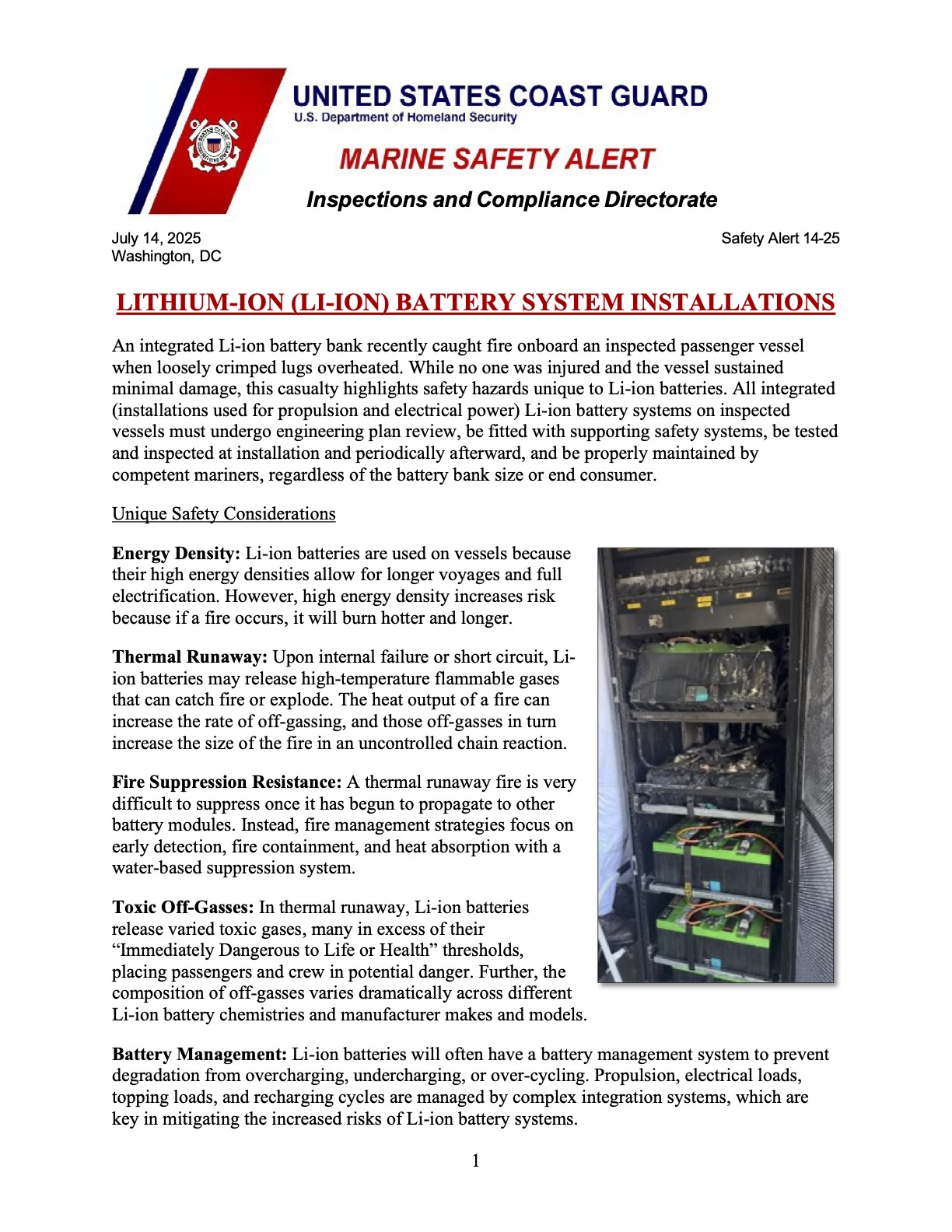
⚠️ U.S. Coast Guard Safety Alert: Lithium-Ion Battery Failures
The U.S. Coast Guard has issued a Safety Alert warning boaters and marine professionals about recent incidents involving Lithium-Ion battery failures, which have caused fires, explosions, and even injuries aboard vessels. The Full Safety Alert is at the bottom of this article. The alert underscores the importance of:
-
Using approved chargers
-
Monitoring batteries while charging
-
Proper installation and ventilation
-
Knowing the signs of thermal runaway (unusual heat, smoke, swelling)
Your boat’s battery system is critical. Understanding the types of batteries used in marine environments can help you make safer, more informed decisions.
🔋 Common Marine Battery Types: Explained
Marine batteries are typically designed for either starting engines, deep cycling, or dual-purpose use. Here’s a breakdown of the most common types:
1. Flooded Lead-Acid (FLA) Batteries
-
Also known as: Wet cell batteries
-
Use case: Engine starting and house loads
-
Pros:
-
Inexpensive
-
Readily available
-
Proven track record
-
-
Cons:
-
Requires regular maintenance (topping off distilled water)
-
Risk of acid spills
-
Off-gassing during charging → needs ventilation
-
-
Safety Note: Not prone to thermal runaway, but improper installation can still pose hazards.
2. Absorbed Glass Mat (AGM) Batteries
-
Type: Sealed lead-acid (SLA)
-
Use case: Popular for both starting and deep cycle
-
Pros:
-
Maintenance-free
-
Spill-proof and vibration-resistant
-
Handles high discharge rates well
-
-
Cons:
-
More expensive than flooded
-
Shorter cycle life than lithium
-
-
Safety Note: Safer than flooded, but overcharging can cause venting.
3. Gel Cell Batteries
-
Type: Sealed lead-acid
-
Use case: House battery banks in sensitive environments
-
Pros:
-
Excellent resistance to vibration and temperature extremes
-
Very low self-discharge rate
-
-
Cons:
-
Sensitive to charging voltage (can be damaged easily)
-
Lower power output than AGM
-
-
Safety Note: Low-maintenance and safe, but requires correct charger settings.
🔋 4. Lithium-Ion (Li-ion) Batteries —
Non-LiFePO₄ Chemistries
-
Chemistries: Includes NMC (Nickel Manganese Cobalt), NCA (Nickel Cobalt Aluminum), LCO (Lithium Cobalt Oxide), etc.
-
Use case: Portable power banks, electric scooters, drones, computers, phones, tablets, older marine battery retrofits (not commonly recommended today)
-
Pros:
-
High energy density (more power in a small package)
-
Lightweight
-
-
Cons:
-
Higher risk of thermal runaway
-
Often lacks integrated safety features
-
Degrades faster with deep cycles or high temps
-
-
Safety Note: These are the types most often involved in Coast Guard safety alerts — when improperly charged, punctured, or overheated, they can catch fire or explode. Avoid for marine house systems unless in UL-certified form with full manufacturer support.
✅ 5. Lithium Iron Phosphate (LiFePO₄) Batteries
-
Chemistry: LiFePO₄ — a specific type of Lithium-ion
-
Use case: Modern house battery banks, electric propulsion systems
-
Pros:
-
Very stable chemistry — far less prone to thermal runaway
-
Long lifespan (2000–7000 cycles)
-
Fast charging, deep discharge capable
-
Lightweight and no off-gassing
-
-
Cons:
-
Higher upfront cost than lead-acid or AGM
-
Needs a proper Battery Management System (BMS) and compatible charger
-
-
Safety Note: Significantly safer than other Li-ion types, and quickly becoming the marine industry standard. But still must be installed and used according to spec.
🧠 Best Practices for Battery Safety Afloat
-
Use marine-grade batteries and components.
-
Always follow manufacturer charging specs.
-
Install a proper BMS for lithium systems.
-
Ventilate battery compartments if using flooded or AGM batteries.
-
Never charge unattended in enclosed spaces.
-
Label battery types clearly and educate crew on emergency procedures.
Comments
You must logged in on the sidebar to view and add comments.


